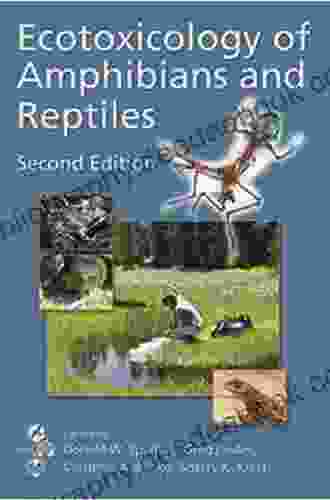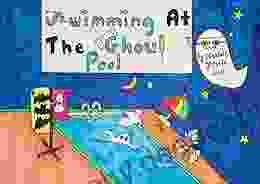Ecotoxicology of Amphibians and Reptiles: A Comprehensive Analysis

Amphibians and reptiles are two of the most vulnerable animal groups to environmental pollutants. They have permeable skin and eggs, which allows pollutants to easily enter their bodies. They also have slow metabolisms, which means that pollutants can accumulate in their tissues over time.
5 out of 5
| Language | : | English |
| File size | : | 30274 KB |
| Screen Reader | : | Supported |
| Print length | : | 944 pages |
The ecotoxicology of amphibians and reptiles is a complex and rapidly evolving field. This article provides a comprehensive overview of the effects of pollutants on amphibians and reptiles, discussing their physiology, behavior, and populations.
Effects of Pollutants on Amphibians and Reptiles
Physiological Effects
Pollutants can have a wide range of physiological effects on amphibians and reptiles. These effects can include:
- Altered growth and development. Pollutants can interfere with the growth and development of amphibians and reptiles, causing deformities, stunted growth, and delayed sexual maturity.
- Impaired immune function. Pollutants can impair the immune function of amphibians and reptiles, making them more susceptible to disease.
- Endocrine disruption. Pollutants can disrupt the endocrine system of amphibians and reptiles, leading to reproductive problems, developmental abnormalities, and other health issues.
- Neurological effects. Pollutants can damage the nervous system of amphibians and reptiles, causing behavioral changes, seizures, and even death.
Behavioral Effects
Pollutants can also have behavioral effects on amphibians and reptiles. These effects can include:
- Altered feeding behavior. Pollutants can alter the feeding behavior of amphibians and reptiles, causing them to eat less or to eat different types of food.
- Impaired predator avoidance. Pollutants can impair the predator avoidance behavior of amphibians and reptiles, making them more vulnerable to predation.
- Increased aggression. Pollutants can increase the aggression of amphibians and reptiles, leading to fights and injuries.
- Reduced reproductive success. Pollutants can reduce the reproductive success of amphibians and reptiles, causing them to produce fewer eggs or to produce eggs that are less likely to hatch.
Population Effects
The effects of pollutants on amphibians and reptiles can have significant population-level effects. These effects can include:
- Population declines. Pollutants can cause population declines in amphibians and reptiles by reducing reproductive success, increasing mortality, and altering habitat quality.
- Altered sex ratios. Pollutants can alter the sex ratios of amphibians and reptiles, leading to a decrease in the number of males or females in a population.
- Reduced genetic diversity. Pollutants can reduce the genetic diversity of amphibians and reptiles, making them more susceptible to disease and environmental change.
- Ecosystem disruption. The decline of amphibians and reptiles can disrupt ecosystems, as they play important roles as predators, prey, and nutrient cyclers.
Sources of Pollution
There are a variety of sources of pollution that can harm amphibians and reptiles. These sources include:
- Industrial pollution. Industrial activities can release a variety of pollutants into the environment, including heavy metals, pesticides, and solvents.
- Agricultural pollution. Agricultural activities can release a variety of pollutants into the environment, including pesticides, fertilizers, and manure.
- Urban pollution. Urban areas can produce a variety of pollutants, including air pollution, water pollution, and noise pollution.
- Climate change. Climate change is increasing the frequency and severity of extreme weather events, such as floods and droughts, which can harm amphibians and reptiles.
Protecting Amphibians and Reptiles from Pollution
There are a number of things that can be done to protect amphibians and reptiles from pollution. These include:
- Reducing pollution at the source. The best way to protect amphibians and reptiles from pollution is to reduce pollution at the source. This can be done by regulating industrial and agricultural activities, reducing the use of pesticides and fertilizers, and promoting sustainable urban development.
- Protecting and restoring habitat. Protecting and restoring habitat is essential for amphibians and reptiles. This includes creating and maintaining wetlands, planting native vegetation, and reducing fragmentation.
- Educating the public. Educating the public about the importance of amphibians and reptiles and the threats they face is essential for protecting these animals. This can be done through school programs, public awareness campaigns, and media outreach.
- Supporting research. Research is essential for understanding the effects of pollution on amphibians and reptiles and for developing effective conservation strategies. This research can be funded by governments, universities, and non-profit organizations.
Amphibians and reptiles are essential components of healthy ecosystems. They play important roles as predators, prey, and nutrient cyclers. However, they are also highly vulnerable to environmental pollutants. The ecotoxicology of amphibians and reptiles is a complex and rapidly evolving field, but research has shown that pollutants can have significant effects on their physiology, behavior, and populations. It is important to take steps to reduce pollution and protect amphibians and reptiles from its harmful effects.
5 out of 5
| Language | : | English |
| File size | : | 30274 KB |
| Screen Reader | : | Supported |
| Print length | : | 944 pages |
Do you want to contribute by writing guest posts on this blog?
Please contact us and send us a resume of previous articles that you have written.
 Novel
Novel Text
Text Story
Story Genre
Genre Reader
Reader Library
Library Paperback
Paperback E-book
E-book Newspaper
Newspaper Paragraph
Paragraph Bookmark
Bookmark Foreword
Foreword Synopsis
Synopsis Footnote
Footnote Manuscript
Manuscript Scroll
Scroll Tome
Tome Bestseller
Bestseller Library card
Library card Reference
Reference Encyclopedia
Encyclopedia Thesaurus
Thesaurus Narrator
Narrator Librarian
Librarian Catalog
Catalog Card Catalog
Card Catalog Periodicals
Periodicals Scholarly
Scholarly Reserve
Reserve Academic
Academic Rare Books
Rare Books Special Collections
Special Collections Interlibrary
Interlibrary Literacy
Literacy Study Group
Study Group Thesis
Thesis Storytelling
Storytelling Awards
Awards Reading List
Reading List Textbooks
Textbooks Lennard J Davis
Lennard J Davis Rebecca Donnelly
Rebecca Donnelly Dimitra Georgiou
Dimitra Georgiou Sandra Day O Connor
Sandra Day O Connor Nicholas Baragwanath
Nicholas Baragwanath Kris Salata
Kris Salata Petru Popescu
Petru Popescu Teresa Peterson
Teresa Peterson Erik Jones
Erik Jones Vincent E Henry
Vincent E Henry James Agee
James Agee Daniel Waters
Daniel Waters Debra May Macleod
Debra May Macleod Richard Gott
Richard Gott Thomas S Hischak
Thomas S Hischak Sarah J Purcell
Sarah J Purcell Angela Smith
Angela Smith Kurt A Knoth
Kurt A Knoth Burt Prelutsky
Burt Prelutsky Pierre Michel Menger
Pierre Michel Menger
Light bulbAdvertise smarter! Our strategic ad space ensures maximum exposure. Reserve your spot today!
 Graham BlairFollow ·4.6k
Graham BlairFollow ·4.6k Leo MitchellFollow ·16.6k
Leo MitchellFollow ·16.6k Fernando BellFollow ·10.5k
Fernando BellFollow ·10.5k Boris PasternakFollow ·9k
Boris PasternakFollow ·9k Ivan TurnerFollow ·9.8k
Ivan TurnerFollow ·9.8k Ryūnosuke AkutagawaFollow ·12.4k
Ryūnosuke AkutagawaFollow ·12.4k Edwin CoxFollow ·18.4k
Edwin CoxFollow ·18.4k George BellFollow ·19k
George BellFollow ·19k

 Braden Ward
Braden WardFeminism's Forgotten Fight: The Ongoing Battle for...
The feminist movement has historically...

 Julio Cortázar
Julio CortázarBlue Heaven Black Night: A Literary Journey Through Love,...
In the realm of...

 Eddie Bell
Eddie BellA Journey Through Time: Exploring the Enchanting World of...
The vibrant tapestry of New...

 Lawrence Bell
Lawrence BellValiance Dragon Soul Press Anthology: A Literary Odyssey...
Step into a realm where...

 Aron Cox
Aron CoxEmbark on a Creative Odyssey with Jean Leinhauser's "101...
Unveil a Kaleidoscope of...
5 out of 5
| Language | : | English |
| File size | : | 30274 KB |
| Screen Reader | : | Supported |
| Print length | : | 944 pages |














